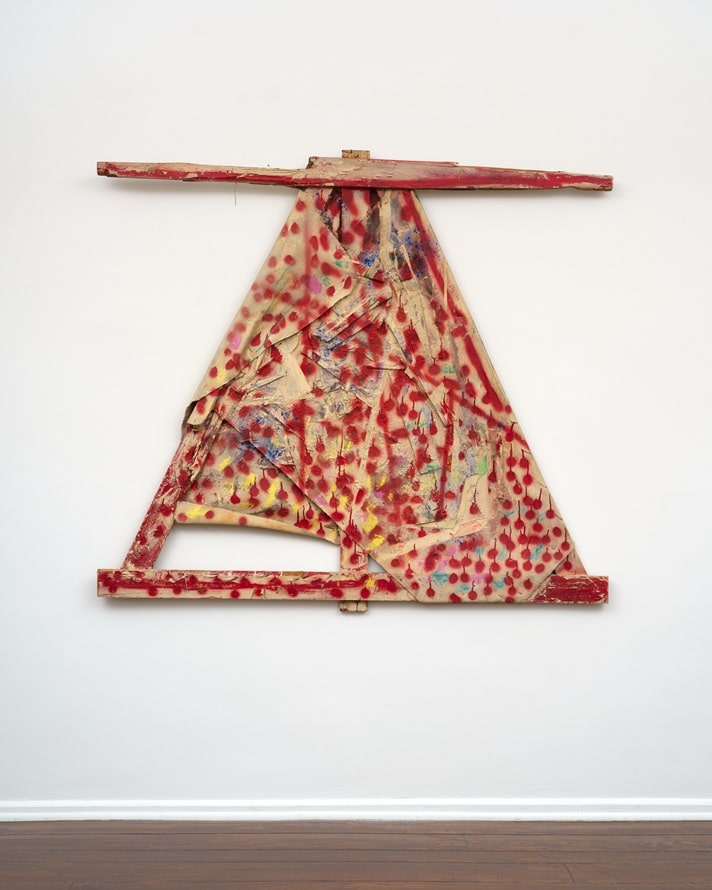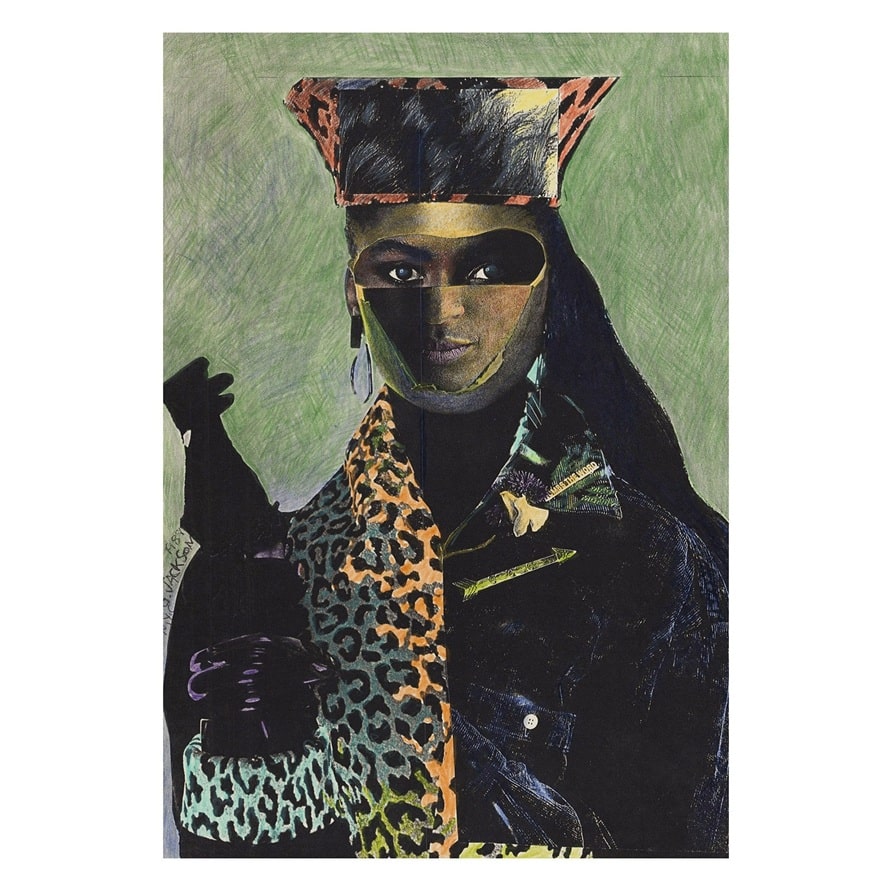The Kienzle Art Foundation presents from Saturday, 3. May 2025 (Opening 2. May) Keep Looking: Works from 1978–2025, the first solo exhibition in Europe by Gerald Jackson (b. 1936, Chicago, USA). The exhibition is guest curated by Matthew Higgs, Director of White Columns—New York’s oldest alternative art space— where Jackson had a solo exhibition in 2021. Among the most mercurial artists of his generation, Jackson has, over the past seven decades, worked fluidly between painting, sculpture, assemblage, collage, drawing, fashion, music, poetry, and performance. Keep Looking, titled after the 1988 song by the British group Sade (one of Jackson’s favorites), is a focused survey of his work made from the late 1970s to the present.
Image above: Gerald Jackson, o.T., 1988, Collage: Fotokopie, Farbstift, Graphit, 43 x 28 cm. © LeWitt Collection, Chester, Connecticut.
After a stint in the U.S. Army, Jackson relocated in the early 1960s from his native Chicago to New York’s Lower East Side, where he would encounter and become a part of a community of vanguard artists and jazz musicians centered around Slugs’ Saloon (1964–72), a now-mythical jazz club on East 3rd Street where Sun Ra once held a Monday night residency. This intersection—of art, music, and life—continues to resonate throughout Jackson’s work. Having initially pursued studies at the School of the Art Institute of Chicago, and later at the Brooklyn Museum Art School, Jackson began to exhibit his own work starting in the mid-1960s.
From the early 1970s through to his eventual eviction in 2002, Jackson lived and worked—with little financial support—in a raw commercial loft on New York’s Bowery alongside other artists and musicians, restaurant supply stores, flophouses, bars, and the area’s large, unhoused population. For Jackson, the Bowery both encapsulated and amplified the harsh realities of American society and its failures, while also providing him with a place of refuge and the freedom to explore his creative vision. In Downtown Manhattan, Jackson found inspiration within a vibrant community of like-minded artists and musicians, among them McArthur Binion, Peter Bradley, Ornette Coleman (Jackson’s one-time roommate), David Hammons, Corrine Jennings, Lorraine O’Grady, Joe Overstreet, Bob Thompson, and Stanley Whitney.
Across his seven-decade-long career Jackson has always responded to the social conditions he experienced throughout his life—including poverty, racism, and violence—through a highly philosophical and conceptual approach to art making infused with poetry and politics. His artworks formally foreground and evidence these strategies, whether through his transformation of detritus into objects of beauty and significance; his use of existing cultural and spiritual languages to construct new, liberating mythologies; or his exploration of the power of color and light as agents of healing and transcendence.

Keep Looking is structured around four related series: Skid works (1980s onward); spray-painted and stenciled works (1970s onward); Jackson’s ongoing explorations of language and color (1980s onward); and a group of innovative hand-made clothing works (1970s onwards).
Jackson’s Skid works were created with found wooden shipping pallets the artist collected from the street below his Bowery loft. The structure of the pallets resembled the reconfigured or deconstructed stretcher bars of a painting, prompting Jackson’s varied responses to the form as both support and ground. Jackson nailed, stapled, wrapped, stretched, and bound lengths of felt strapping, electrical wires, and canvas onto and around the bars. He then painted and applied areas of vibrant, textured pigment and segments of broken wood to the surfaces. The resulting hybrid objects, which he calls Skids, privilege the artist’s attuned sensitivity to materials and form, and his ingenious capacity to transform the marginal and disregarded into profound objects of contemplation.
Since the 1970s Jackson has developed his own vocabulary of spray-painted pictographs made with both found and handmade stencils. He deploys the graphic images as optical patterns, which he layers across the surface of bedsheets, panels, stretched canvases, and garments. The recursive symbols—often augmented with portrait images—evoke a kind of timeless and universal visual form of storytelling rooted in cultural and spiritual references both ancient and modern, such as prehistoric cave paintings, graffiti, and early video games.

For Jackson language and color have endured as foundational social and political concerns, inherently bound with experience and the possibility of empowerment and liberation. In his ongoing body of work dedicated to blue and green, Jackson embraces the colors’ associative power (green for verdant earth and blue for sky and water) and their spiritual qualities. In a related visceral work from this series Jackson incorporates a détourned image of Da Vinci’s Vitruvian Man, effectively erasing the central figure with charcoal and oil stick. In his recent text drawings, words denoting specific colors (i.e., “BLACK” or “RED”) are written on sheets of typing paper, which are then arranged into grid-like formations. Suggesting a kind of abstraction through language, Jackson’s staccatolike text drawings oscillate between a form of concrete poetry and something closer to a musical or lyrical score. In Jackson’s recent figurative collage works, including those from the series Divine Providence, aspects of the artist’s biography—including self-portrait images—are juxtaposed with his own writings, found imagery and symbols, and fragments of musical scores by both Mozart and Ornette Coleman.
Each of the galleries at the Kienzle Art Foundation is connected by the presence of a mannequin outfitted in one of Jackson’s hand-made, functional clothing works. These outfits—adroitly described in 2003 by the art dealer Jack Tilton as “chop and paste clothing” and as a form of “three-dimensional funk”—were often worn by the artist, as can be seen in Peter Bellamy’s 1987 portrait of Jackson in his studio clad in a handstenciled overcoat with works from the Skids series behind him. As the critic Roberta Smith observed in 2021 writing in the New York Times: “Multicultural in their references and dazzling in their colors, these garments suggest a global sophistication. They are made for citizens of the world.”
Text: Matthew Higgs
WHEN?
Opening: Friday, 2 May 2025, 6 to 9 pm
Exhibition period: Saturday, 3. May until Saturday, 5. July 2025
Opening hours: Thu and Fri: 1 – 6 pm, Sat: 2 – 6:30 pm
WHERE?
Kienzle Art Foundation
Bleibtreustrasse 54
10623 Berlin






